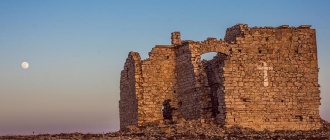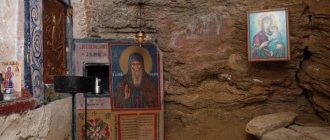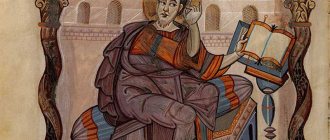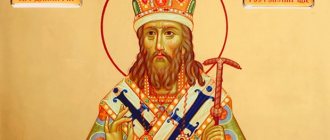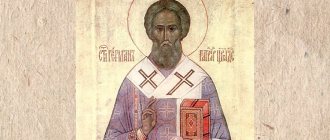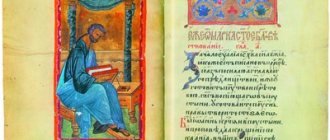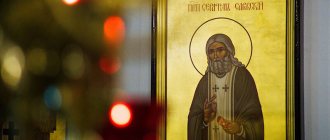September 1 Word on the first day of the indictment, or new year The life of our venerable and God-bearing father Simeon the Stylite Memory of the righteous Joshua Remembrance of the Council of the Most Holy Theotokos, which is in the Miasin monastery Memory of the saints 40 virgins of fasting and Ammun, their teacher Memory of the holy martyrs Callista and her brothers Evoda and Hermogenes
September 2 Life and suffering of the holy martyr Mamantas Life of St. John the Faster, Patriarch of Constantinople Memory of the 3618 martyrs who suffered in Nicomedia
September 3 The life and suffering of the holy hieromartyr Anthimus, Bishop of Nicomedia, and with him many On the same day, the suffering of the holy martyr Vasilisa On the same day the memory of the holy hieromartyr Aristion
September 4 The Suffering of the Holy Hieromartyr Babyla, and with him the Three Youths The Life of the Holy Prophet Moses the Seer of God The Memory of the Holy Martyrs Theodore, Miana, Julian, and Kion The Memory of the Holy Hieromartyr Babyla of Nicomedia and with him 84 Children The Memory of the Holy Martyr Hermionia
September 5 The Life of the Holy Prophet Zechariah The Memory of the Holy Martyrs Urvan, Theodore and Medimnus, and many with them The Memory of the Holy Martyr Obadiah The Memory of the Holy Martyrs Thephael and Thebes The Assassination of the Holy Prince Gleb The Celebration of the Holy Apostle Peter, in Aphira The Memory of the Holy Martyrs Iuventinus and Maximus
September 6 Remembrance of the miracle of the Holy Archangel Michael in Khoneh The Suffering of the Holy Martyr Romilus The Suffering of the Holy Martyr Eudoxia Memory of the Hieromartyr Cyril, Bishop of Gortyn Life of the Venerable David Memory of the Holy Martyrs Cyriac, Faustus and Aviv
September 7 The Suffering of the Holy Martyr Sozontas The Memory of the Holy Apostles Evodas and Onesiphoros The Memory of the Holy Martyr Eupsychios The Life of Our Holy Father John, Archbishop of Novgorod
September 8 Word for the Nativity of the Virgin Mary
September 9 The Life of the Saints and Righteous Father of God Joachim and Anna The Suffering of the Holy Martyr Sevirian The Memory of Blessed Nikita, the Secret Saint of God, whom Deacon Sozont saw The Memory of the Holy Third Ecumenical Council in Ephesus The Memory of the Venerable Joseph of Volokolamsk The Memory of the Venerable Theophan, Faster and Confessor
September 10 The Life and Suffering of the Holy Martyrs Minodora, Metrodora and Nymphodora The Life of the Holy Queen Pulcheria Memory of the Saints Three Wives Found in a Desert Mountain Memory of the Holy Martyr Baripsaus Memory of the Holy Apostles Appellius, Luke and Clement
September 11 Life and exploits of our venerable mother Theodora, who labored as a man Memory of St. Euphrosynus Memory of the holy martyr Ia Memory of the holy martyrs Diodorus and Didymos
September 12 The Life and Suffering of the Holy Hieromartyr Autonomus The Memory of the Hieromartyr Cornutus, Bishop of Nicomedia The Memory of the Holy Martyr Julian
September 13 Word on the renewal of the Jerusalem Church of the Resurrection of Christ Life of the Hieromartyr Cornelius the Centurion Memory of Sts. mchch. Gordiana, Macrovius, Elijah, Zotik, Lucian and Valerian Memory of St. Peter in Atroe Memory of Sts. martyrs Seleucus, Stratonikos, Cronidas, Leontius and Serapion
September 14 The Legend of the Exaltation of the Honest and Life-Giving Cross of the Lord Memory of the Holy Martyr Papias
September 15 The Suffering of the Holy Martyr Nikita Memory of Saint Philotheus, presbyter and wonderworker Memory of the Holy Martyr Porphyry Memory of the Holy Martyrs Maximus, Askliadas and Theodotus
September 16 The Suffering of the Holy All-Honorable Great Martyr Euphemia Memory of the Holy Martyr Sebastiana Memory of the Holy Martyr Melitina Memory of the Holy Martyr Lyudmila Memory of Saint Cyprian, Metropolitan of Kiev Memory of the Venerable Dorotheus the Hermit
September 17 The suffering of the holy martyrs Faith, Hope and Love, and their mother Sophia Memory of the holy martyr Agathoclia Memory of the holy martyr Theodotia
September 18 Our Reverend Father Eumenius, Bishop of Gortyn Memory of the Holy Martyr Ariadne
September 19 The Suffering of the Holy Martyrs Trophimus, Savvatius and Dorimedont The Suffering of the Holy Martyr Zosima the Hermit Memory of the Holy Blessed Prince Theodore, the Wonderworker of Smolensk and Yaroslavl, and his children David and Constantine
September 20 Life and suffering of St. Great Martyr Eustathius Placida, his wife and children The Suffering of the Holy Martyrs Michael, the Prince of Chernigov and his Boyar Theodore, who suffered from the wicked Batu
September 21 Holy Apostle Codratus Memory of the holy martyrs Hypatius and Andrew Memory of the holy martyrs Eusebius and Priscus Memory of the holy bishops Isaac and Meletius Life of Saint Demetrius, Metropolitan of Rostov, wonderworker
September 22 The Suffering of the Holy Hieromartyr Phocas, Bishop of Sinope The Life and Suffering of the Holy Martyr Phocas, called the Vertodarar The Life of the Holy Prophet Jonah The Memory of the Venerable Jonah the Presbyter The Life of St. Peter, Formerly a Publican
September 23 Sermon on the conception of the honest and glorious prophet, forerunner and baptist of the Lord John Memory of the holy martyrs Andrew, John, Peter and Antonin Memory of the holy martyr Iraida Life of the Venerable Polyxenia
September 24 The Life and Suffering of the Holy First Martyr, Equal-to-the-Apostles Thekla Memory of the Venerable Coprius The Life of our Venerable Father Nikander of Pskov
September 25 The Life of our Venerable Mother Euphrosyne The Life and Miracles of our Venerable and God-Bearing Father Sergius, the Wonderworker of Radonezh The Life of the Venerable Euphrosyne of Suzdal In Memory of the Venerable Martyr Paphnutius
September 26 Life of the Holy Apostle and Evangelist John the Theologian
September 27 The Life and Suffering of the Holy Martyr Callistratus The Life of our Venerable Father Savvatius of Solovetsky, the Wonderworker Memory of the Holy Apostles Mark, Aristarchus and Zina Memory of the Holy Martyr Epicharia Memory of Saint Ignatius
September 28 Life of our venerable father Chariton the Confessor Memory of the holy prophet Baruch Memory of the holy martyrs Alexander, Alpheus, Zosima, Mark, Nikon, Neon and Iliodor Life of Saint Vyacheslav, Prince of Czech
September 29 Life of our venerable father Kyriakos Memory of the holy martyrs Dada, Gavedday and Kazdoi Memory of Saint Theophan
September 30 The Life and Suffering of the Holy Hieromartyr Gregory, Bishop of Great Armenia, and with him thirty-seven virgins The Life of our Reverend Father Gregory, Abbot of the monastery on the Pelshma River, Vologda Wonderworker Memory of St. Michael, Metropolitan of Kiev and All Russia Wonderworker
MIRACLES
Once, when I was about six years old, there was such a case: we lived in a dacha on our estate near Orenburg. Our house stood in a huge garden-park and was guarded by a guard and dogs, so it was impossible for an outsider to enter the park unnoticed.
One day my father and I were walking in the park, and suddenly, out of nowhere, an old man appeared in front of us. Approaching my father, he said: “Remember, father, that this child will one day drag souls from hell.”
A year before I entered the Skete, on the second day of the Nativity of Christ, I was returning from early mass. It was still dark and the city was just beginning to wake up. Suddenly an old man came up to me, asking for alms. I realized that I didn’t take my wallet with me, and there were only twenty kopecks in my pocket. I gave them to the old man with the words: “I’m sorry, I don’t have them with me anymore.” He thanked me and handed me the prosphora. I took it, put it in my pocket and just wanted to say something to the beggar, but he was no longer there. I looked everywhere in vain; he disappeared without a trace. The next year on this day I was already in Skete.
If you look at life carefully, it is all full of miracles, but we often do not notice and pass by them indifferently. May the Lord give us the wisdom to carefully spend the days of our lives, working out our salvation with fear and trembling.
The former abbot of the Meshchovsky Monastery, Fr. Mark, now living in retirement in Optina Pustyn: “I remember, it was, it seems, in 1867. I was very sick and did not expect to get up. At this time I lived in Optina. One day I see, as if in a subtle dream, as if I was standing in a clearing near Kozelsk, and opposite three Churches. The sun is rising. There are some creatures standing next to me on the right and left sides. I notice that the sun that I see is an icon standing in the attic of the Ascension Church. To my question to the one who stood next to me on the left side, he answered: “I am George! The icon you see is the icon of the Akhtyra Mother of God.” When he woke up, he told Fr. Ambrose. A search began in all the churches of the city of Kozelsk, but the icon of the Akhtyrskaya Mother of God was not found anywhere. They also searched in the Ascension Church. After a long and unsuccessful search, the priest of that Church, Fr. Demetrius discovered this icon in the attic of the Church, lying in dust and debris. The holy icon was then solemnly brought to Optina, and I, having venerated it after the prayer service, received relief from my illness and soon recovered completely.”
After this miracle, many came to her with faith from this icon. To this day, St. This icon is located in the Church of the Ascension in the city of Kozelsk and is revered by the residents as miraculous.
When I was returning from Manchuria by rail, I wanted to be alone at night - whether I was sad or something else, I don’t remember. I went into the hallway of the carriage, so to speak, I mean that small room, of which there are usually two in every carriage: in front and in back; they have 4 doors: one leads to the carriage, the other to the platform to the next carriage, and two to the right and left for passengers to exit. I went out and leaned on one door and thought: “Glory to You, Lord. I’m going to dear Optina again.” And I wanted to go to the opposite side door, I walked and suddenly, as if by some force, I was pushed away. I stopped in the middle and, looking closely, I saw that the door was pushed to the side (there are doors of such a device), which I did not notice in the dark, but wanted to lean my elbows on it. And what would have happened... The Lord saved...
Lives of Saints by Metropolitan Macarius
A new era in the history of Russian lives is constituted by the activities of the All-Russian Metropolitan Macarius. His time was especially rich in new “lives” of Russian saints, which is explained, on the one hand, by the intense activity of this metropolitan in the canonization of saints, and on the other, by the “great Menaions-Chetii” he compiled. These menaions, which included almost all the Russian lives available at that time, are known in two editions: the Sophia edition (manuscript of the St. Petersburg Spiritual Academy) and the more complete edition of the Moscow Council of 1552.
Lives of saints other than martyrologies
The literature of the “Lives of Saints” of the second kind - the venerables and others - is more extensive. The oldest collection of such tales is Dorothea, Bishop. Tyrian (+ 362), - a legend about the 70 apostles. Of the others, especially remarkable:
- “The Lives of Honest Monks”, Patriarch Timothy of Alexandria (+ 385);
- Lausaic Palladia, (“Historia Lausaica, s. paradisus de vitis patrum”;
- “Historia Christiana veterum Patrum” 1582, original text in ed. Renata Lavrentia;
- "Opera Maursii", Florence, 1746, vol. VIII; there is also a Russian translation, 1856);
- Works of Theodoret of Cyrrhus (+ 458) - (in the named edition of Renata) as well as in the complete works of Theodoret; in Russian translation - in “Works of St. Fathers", ed. Moscow spirit. Academy and previously separately);
- “Lemon garden, that is, a flower garden,” by John Mosch (Leimwnarion, in “Vitae patrum”, Rossveiga, Antv. 1628, vol. X; Russian edition - M. 1859).
In the West, the main writers of this kind during the patristic period were:
- Rufinus of Aquileia (“Vitae patrum s. historiae eremiticae”);
- John Cassian (“Collationes patrum in Scythia”);
- Gregory), bishop. Tours (died 594), who wrote a number of hagiographic works (“Gloria martyrum”, “Gloria confessorum”, “Vitae patrum”),
- Grigory Dvoeslov (“Dialogi” - Russian translation “An Interview on the Life of the Italian Fathers”, in “Orthodox Interlocutor” [2].
"Moral hagiography"
From v. a new feature appeared in the literature of the “Lives of the Saints” - a tendentious (moralizing, partly political-social) direction, decorating the story about the saint with fictions of fantasy. Among such hagiographers, the first place is occupied by Simeon Metaphrastus, a dignitary of the Byzantine court, who lived, according to some, in the 9th century, according to others in the 10th or 12th century. He published “The Lives of the Saints,” which constitute the most widespread primary source for subsequent writers of this kind not only in the East, but also in the West, among whom are Varaggio, Archbishop. Genoese, (+ 1298), who compiled the Golden Legend (“Legenda aurea sanctorum”) and Peter Natalibus, (+ 1382) - author of the Holy Catalog (“Catalogus Sanctorum”).
Subsequent editions take a more critical direction:
- Bonina Mombrizia, “Legendarium s. acta sanctorum" (1474);
- Aloysius Lippomana, bishop. Verona, “Vitae sanctorum” (1551 - 1560);
- Lawrence Surius, Cologne Carthusian, “Vitae sanctorum orientis et occidentis” (1664);
- George Vicella, “Hagiologium s. de sanctis ecclesiae";
- Ambrose Flaccus, “Fastorum sanctorum libri XII”;
- Renata Laurentia de la Barre - “Historia Christiana veterum patrum”;
- C. Baronia, “Annales ecclesiast.”;
- Rosweida - “Vitae patrum”;
- Radera, “Viridarium sanctorum ex minaeis graecis” (1604).
Approaches to studying the lives of saints
The lives of saints can be studied from historical-theological, historical, socio-cultural and literary points of view.
From a historical and theological point of view
The lives of saints are studied as a source for reconstructing the theological views of the era of the creation of the life, its author and editors, their ideas about holiness, salvation, deification, etc.
Historically
Lives, with appropriate historical and philological criticism, act as a first-class source on the history of the church, as well as on civil history.
In the socio-cultural aspect
Lives make it possible to reconstruct the nature of spirituality, the social parameters of religious life (in particular, the so-called folk religiosity), and the religious and cultural ideas of society.
Lives, finally, constitute perhaps the most extensive part of Christian literature
, with their own patterns of development, the evolution of structural and content parameters, etc., and in this regard are the subject of literary and philological consideration.
History of hagiography
From the first days of its existence, the Christian Church carefully collects information about the life and activities of its ascetics and reports them for general edification. The Lives of the Saints constitute perhaps the most extensive section of Christian literature. Apart from the apocryphal gospels and tales of the apostles, which contain a lot of detailed information about the first figures of Christianity, the first “Lives of the Saints” were tales of martyrs.
Martyrology of the first centuries AD
Also St. Clement, bishop The Roman, during the first persecution of Christianity, appointed seven notaries in various districts of Rome to daily record what happened to Christians in places of execution, as well as in prisons and courts. Another bishop of Rome, smch. Fabian (236 - 251), entrusted this work to seven subdeacons.
Biographer of St. Cypriana mentions that the names of martyrs, even of the simplest rank, have been recorded by churches since ancient times for honor and remembrance. Despite the fact that the pagan government threatened the recorders with the death penalty, recordings continued throughout the persecution of Christianity.
Under Domitian and Diocletian, a significant part of the records perished in the fire, so when Eusebius (+ 340) undertook the compilation of a complete collection of legends about the ancient martyrs, he did not find sufficient material for that in the literature of martyrdom acts, but had to do research in the archives of institutions that produced trial of the martyrs. Eusebius’s work on the martyrs has not survived to our time, but another of his works is known: “The Book of the Palestinian Martyrs.” From the first three centuries, few more “epistles” about martyrdom have reached us from one church to another.
After Eusebius, tales of martyrdom were collected by St. Marufa, ep. Mesopotamian (c. 410), author of the History of the Persian Martyrs.
Medieval martyrology
Monk of the Benedictine monastery of St. Herman near Paris, Usuard (c. 876), compiled the oldest martyrology in the West (“Usuardi martyrologium”, published in Louvain, 1568, and Antwerp, 1714). The later, more complete collection and critical edition of the acts of the martyrs belongs to the Benedictine Ruinart: “Acta Martyrum sincera et selecta” (Par. 1689; French translation: Drouet-de-Maupertoy).
Martyrology of the New Time
Among the newest collections worthy of attention:
- Zingerle, "Martyrer des Morgenlandes" (Jen 1833)
- Adalbert Müller, "Allgemeines Martyrologium" (1860).
Russian martyrology
The following works are known in Russian literature:
- Priest V. Guryev, “Warrior Martyrs” (1876);
- Prot. P. Solovyov, “Christian martyrs who suffered in the East after the conquest of Constantinople by the Turks” (translated from modern Greek St. Petersburg, 1862);
- “Tales of Christian Martyrs Honored by the Orthodox Church” (Kazan, 1865).
Liturgical martyrologies
Along with these collections of more or less detailed tales of martyrs, beginning in the century, and perhaps earlier, short martyrologies were developed (especially in the West) for use during divine services. They are based on a martyrology attributed (according to some, erroneously) to Jerome [1].
Of the later known:
- Assemani, “Acta ss. martyrum orientalium et occidentalium" (1748);
- Lagrange, "Choix des actes des martyrs d'Orient" (Par. 1862).
In addition to the general ones, in the West there are also local martyrologies of countries or nationalities:
- African martyrology (Steph. Macelli),
- Belgian martyrology (Molana),
- German martyrology (Valasser),
- Spanish martyrology (Salazzara),
- English martyrology (Wilson),
- Italian martyrology (Cornelia)
and etc.
Activities of Bolland and his followers
Finally, the famous Antwerp Jesuit Bolland comes forward with his activities; in 1643 he published the 1st volume of “Acta sanctorum” in Antwerp. Over the course of 130 years, the Bollandists published 49 volumes containing the Lives of the Saints from January 1 to October 7; by 1780 two more volumes had appeared.
In 1788, the Bollandist Institute was closed. Three years later, the enterprise was resumed again, and in 1794 another new volume appeared. When Belgium was conquered by the French, the Bollandist monastery was sold, and they themselves and their collections moved to Westphalia and, after restoration, published six more volumes. The latter works are significantly inferior in merit to the works of the first Bollandists, both in the vastness of their erudition and due to the lack of strict criticism. The above-mentioned “Martyrologium” by Müller is a good abbreviation of the Bollandist edition and can serve as a reference book for it. A complete index to this edition was compiled by Pothast [3]. All the lives of the saints, known with separate titles, are counted by Fabricius in the Bibliotheca Graeca, Gambus. 1705 - 1718; second edition of Gamb. 1798 - 1809).
Differences between Eastern and Western traditions of describing the lives of saints
In principle, the life of a saint is not so much a description of his life (biography), but a description of his path to salvation, such as his holiness. Therefore, a set of standard motifs reflects, first of all, not literary techniques for constructing a biography, but the dynamics of salvation, the path to the Kingdom of Heaven that was laid out by this saint. Life abstracts this scheme of salvation, and therefore the description of life itself becomes generalized and typical. The very method of describing the path to salvation can be different, and it is in the choice of this method that the Eastern and Western hagiographic traditions differ most. Western lives are usually written in a dynamic perspective; the author, as it were, traces from his position, from earthly existence, which road the saint took from this earthly existence to the Kingdom of Heaven. For the Eastern tradition, the opposite perspective is more typical, the perspective of a saint who has already reached the Heavenly Kingdom and is looking from above on his way to it. This perspective contributes to the development of an ornate, decorated style of hagiography, in which the rhetorical richness is designed to correspond to the incomprehensible height of the view from the Kingdom of Heaven (such, for example, are the lives of Symeon Metaphrastus, and in the Russian tradition - Pachomius the Serb and Epiphanius the Wise). At the same time, the features of the Western and Eastern hagiographic traditions obviously correlate with the characteristic features of Western and Eastern iconography of saints: the plot nature of Western iconography, revealing the path of saints to God, is contrasted with the static nature of Byzantine iconography, which depicts primarily the saint in his glorified, heavenly state. Thus, the nature of hagiographic literature is directly correlated with the entire system of religious views, differences in religious and mystical experience, etc. Hagiography as a discipline studies this entire complex of religious, cultural and literary phenomena.
Other hagiographic works in the West
Individuals in the West continued to publish the lives of saints simultaneously with the Bollandist corporation. Of these, worthy of mention:
- Abbot Commanuel, “Nouvelles vies de saints pour tous le jours” (1701);
- Ballier, “Vie des saints” (work strictly critical),
- Arnaud d'Andili, "Les vies des peres des deserts d'Orient" (1771).
Among the newest Western publications, the Lives of the Saints deserves attention. Stadler and Heim, written in dictionary form: “Heiligen Lexicon”, (1855).
Features of the literary and philological approach to the lives of saints
The literary and philological study of lives serves as the basis for all other types of research. Lives are written according to certain literary canons, which change over time and are different for different Christian traditions. Any interpretation of hagiographic material requires a preliminary consideration of what falls within the realm of literary etiquette. This involves studying the literary history of hagiographies, their genres, establishing typical schemes for their construction, standard motifs and depiction techniques, etc. So, for example, in such a hagiographic genre as praise of a saint, which combines the characteristics of life and sermon, there is a fairly clear compositional structure (introduction, main part and epilogue) and thematic scheme of the main part (the origin of the saint, birth and upbringing, deeds and miracles , righteous death, comparison with other ascetics); These characteristics go back to the late antique encomium, and their different implementations in the process of development of hagiographic literature provide significant material for both historical-literary and historical-cultural conclusions.
Hagiographic literature is characterized by numerous standard motifs, such as the birth of a saint from pious parents, indifference to children's games, etc. Similar motifs stand out in hagiographic works of different types and different eras. Thus, in the acts of martyrs, starting with the most ancient examples of this genre, the prayer of the martyr before death is usually given and tells about the vision of Christ or the Kingdom of Heaven, which is revealed to the ascetic during his suffering. These standard motifs are determined not only by the orientation of some works to others, but also by the Christocentricity of the very phenomenon of martyrdom: the martyr repeats the victory of Christ over death, testifies to Christ and, becoming a “friend of God,” enters the Kingdom of Christ. This theological outline of martyrdom is naturally reflected in the structural characteristics of martyrdom.
